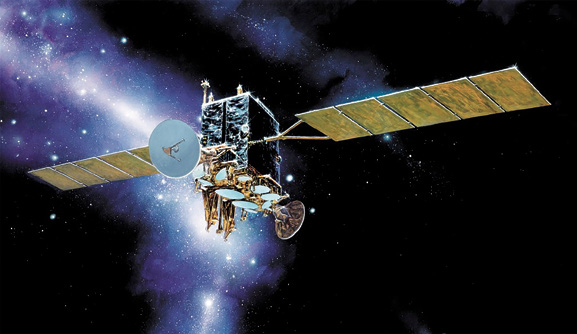When one thinks of the North Pole, it’s probably not about how our military forces communicate in that frigid region of the world. Thankfully, there are plenty of people that do think about these challenges every day and they work on a program called EPS.

Whether it’s via emails, instant messaging, or secure media and data communications, all in order to support our national security objectives, our military forces need to communicate in this remote region, which is out of view to traditional MILSATCOM assets.
What Is EPS?
EPS is the next-generation SATCOM system that will replace the current Interim Polar System (IPS) and serve as a polar adjunct to the Advanced EHF system, which will provide communications for the National Command Authority (NCA), military
tactical and strategic forces, and other user communities. EPS will provide continuous coverage to terminals operating in the polar region and support secure, jam-resistant, strategic and tactical communications between forces operating above 65 degrees north latitude (defined as the Polar Field of View or PFOV) and mid-latitude users.
EPS consists of the following segments:
– EPS Payload Segment
– EPS Terminal Segment
– EPS Control and Planning Segment (CAPS)
– EPS Gateway Segment
Northrop Grumman’s Role
Northrop Grumman is the prime contractor for the EPS payloads and the CAPS program and has delivered both EPS payloads that will be hosted on government satellites. EPS takes advantage of technologies Northrop Grumman developed for Advanced EHF satellite payloads, such as the eXtended Data Rate waveform. This approach allows the payloads to be developed at a fraction of the time and cost. Mission success for EPS is greatly enhanced by the government’s leveraging of Northrop Grumman’s AEHF payload designs, processes, facilities and people.
EPS CAPS is being developed using a combination of proven processes, experienced staff and software reuse from its heritage customer base and products originally developed to support Wideband Global SATCOM. The team has since completed its segment preliminary design review, supported the EPS Program Office’s system preliminary design review, and is in the midst of preparing for a critical design review in the spring of 2014.
Critical Communication Within The Program
As one can imagine—with the challenges of sequestration and ongoing federal budget uncertainties—the environment is tough for a future system to make methodical progress. We have learned that close and frequent communication with our customer in this environment is essential to program success. Northrop Grumman is extremely fortunate to have a customer focused on the program’s bottom line budget and schedule, while delivering a system that meets user needs. There is no room or time for requirements creep. Our team continues to have very frank discussions on CAPS program status, ensuring that we remain on cost and schedule.
Although the mix of reuse and new software, driven by Northrop Grumman’s low risk development approach, was desired by the customer, the other primary guiding principle was designing for the future, e.g., the early application of Modular Open Systems Approach (MOSA) principles so that the architecture can tolerate change in mission capability as well as technology without significant impacts to cost and schedule.
Innovation Through Design
EPS CAPS is using a design methodology that is quite mature in the airplane segment of the company, but relatively new to the Department of Defense’s space side of the business. Model driven engineering (MDE) embraces a top-down, hierarchical breakdown of the systems with many different viewpoints (operational, system, behavioral). MDE bridges the traditional systems engineering process and the software design approach and provides traceability between the user mission threads, system functions, and the software modules that implement the functions.
This tight linking of the operational requirements of the system to the system design minimizes risk to operational suitability. Deploying this “novel” approach to design work also requires a close alignment with the customer as they become familiar with the approach and oversight.
Shortly after our preliminary design review/software architecture review, Northrop Grumman assisted the EPS program office at Los Angeles Air Force Base with their overall system preliminary design review. The system preliminary design review concentrated on ensuring all EPS requirements have been allocated across all three segments. Plans were also reviewed for software development, test and evaluation, specialty engineering analysis, plans for verification and validation, as well as program risk updates.

Artistic rendition of an AEHF satellite for MILSATCOM.
Also provided were inputs on our overall software architecture and schedule plans. A great job was accomplished with their operational customers as to how each segment of EPS—space, ground, gateways, and terminals—meets their requirements and will all fit together in time for the initial operating capability in 2018.
As CAPS is based on software reuse and other existing products, the real program challenges are proving the usability of those components and then integrating them. We are doing that through risk reduction activities and early confident testing.
Our biggest challenge preparing for the CAPS critical design review (CDR) in April of 2014 is to prove that the overall design and software architecture effectively integrates our new and reused code and satisfies the requirement for the payload control and mission planning. This demonstrates the completeness and effectiveness of the design. The current schedule confidence and risk posture support potential early deliveries.
The idea behind these processes and architectural approaches is to develop a foundation for future ground systems that is tailorable to future mission requirements. CAPS is built on Cornerstone and other reuse products from multiple programs of record. This provides an affordable, expandable baseline applicable to new missions and needs. This architecture is underpinned by our MDE and MOSA-C™ processes.
 For further company information, please access their website at:
For further company information, please access their website at:
http://www.northropgrumman.com/AboutUs/BusinessSectors/InformationSystems/Pages/default.aspx
About the author
Michael Mantz is the program manager for EPS CAPS. He has been working with Northrop Grumman for seven years in various capacities from business development to program management. Prior working at Northrop Grumman, he worked for the Air Force for 27 years in space acquisition and operations. Michael graduated with a BS in Electrical Engineering from the United States Air Force Academy in 1976 and with an MS in Aeronautical and Astronautical Engineering from Massachusetts Institute of Technology in 1981. He has attended multiple Air Force and Northrop Grumman Corporation executive management development courses and schools.


